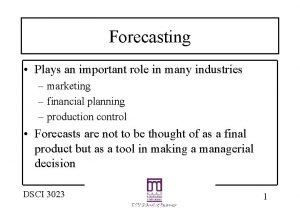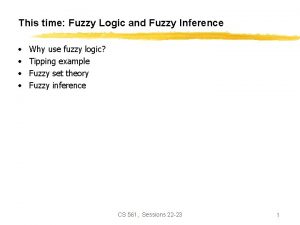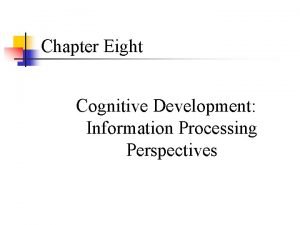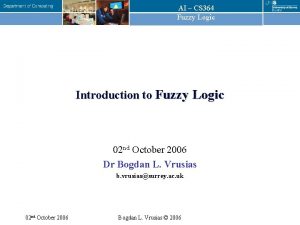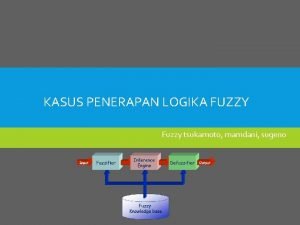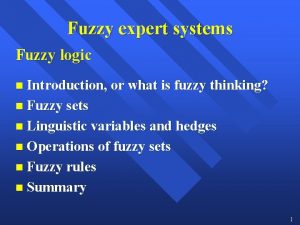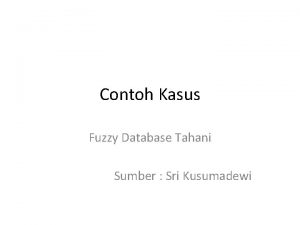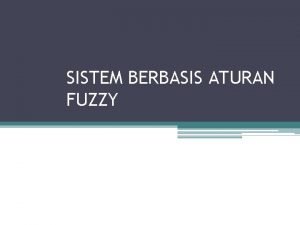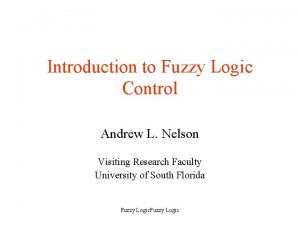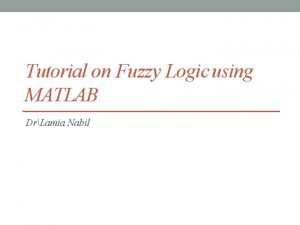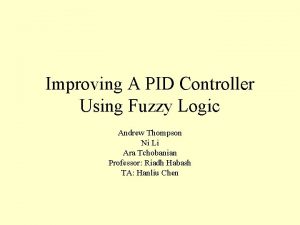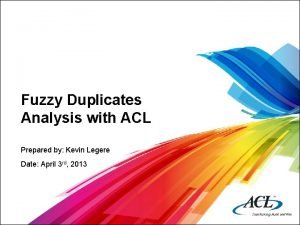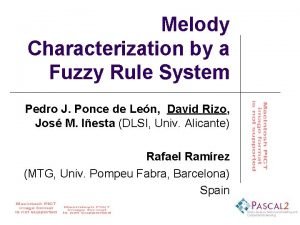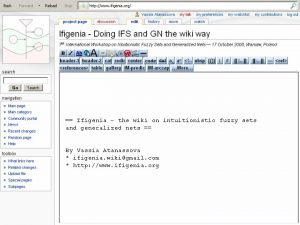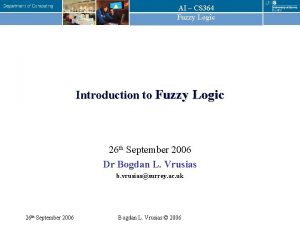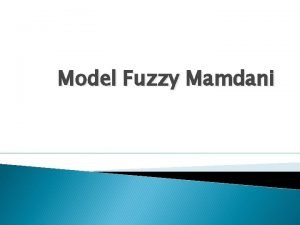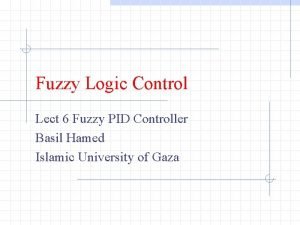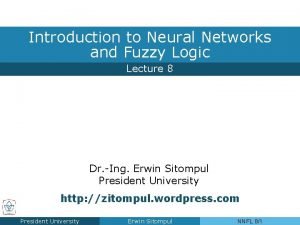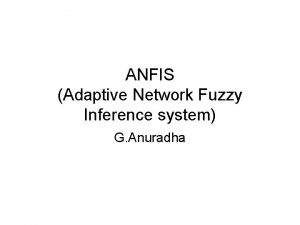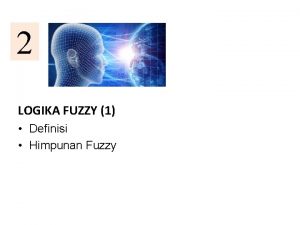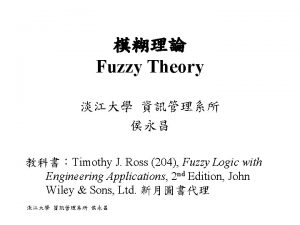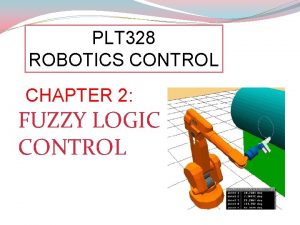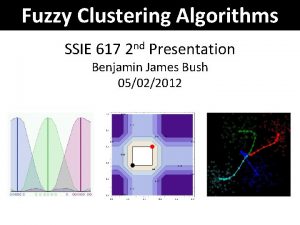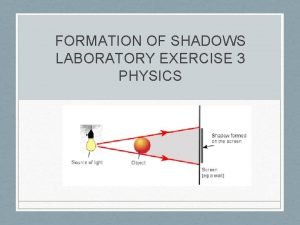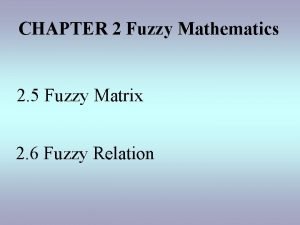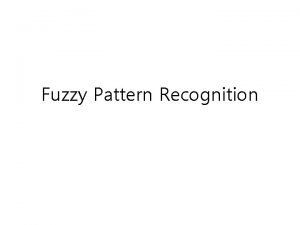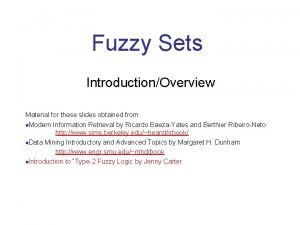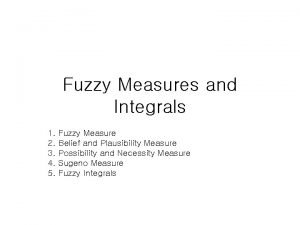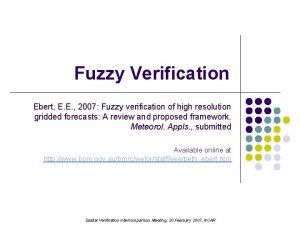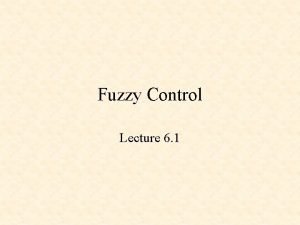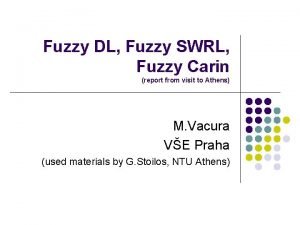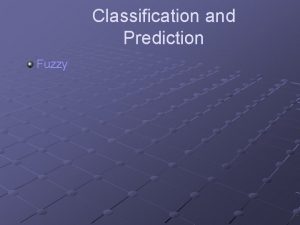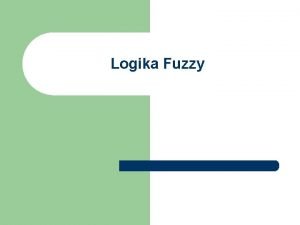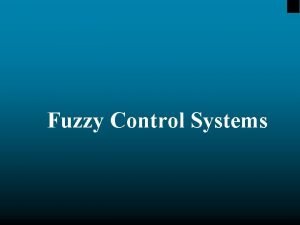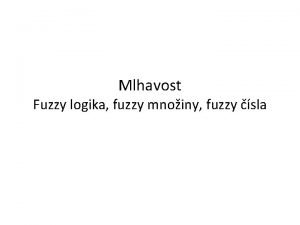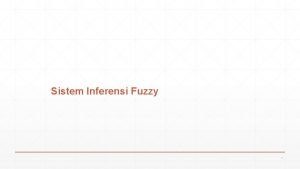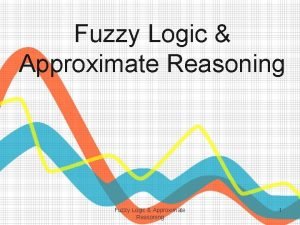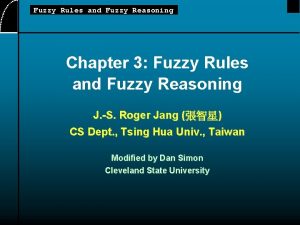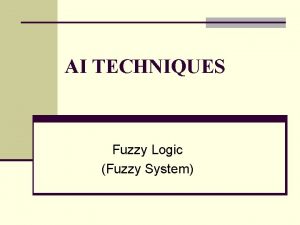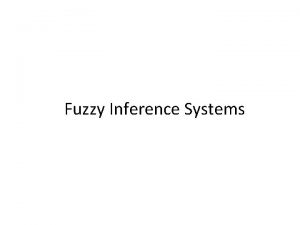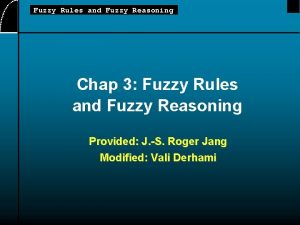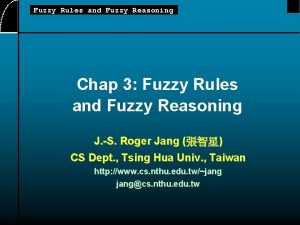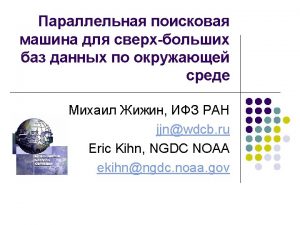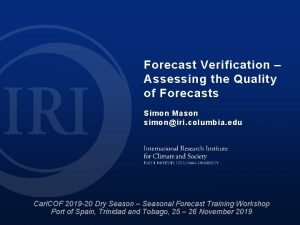Fuzzy Forecast Verification Giving credit to close forecasts















































- Slides: 47

Fuzzy Forecast Verification Giving credit to close forecasts Beth Ebert Centre for Australian Weather and Climate Research Melbourne, Australia Thanks to Felix Ament, Tatjana Bähler, Nigel Roberts, Barbara Casati, Uli Damrath, Fred Atger, Urs Germann, Mike Kay, Susanne Theis, Daniela Rezacova, Mike Baldwin 1 NCEP 29 April 2008

Outline l l l Motivation What is fuzzy verification? Framework for fuzzy verification Demonstration – WRF high resolution rain forecast Comparison with entity-based (CRA) approach Spatial Verification Methods Intercomparison Project NCEP 29 April 2008 2

High vs. low resolution Which rain forecast would you rather use? Mesoscale model (5 km) 21 Mar 2004 Global model (100 km) 21 Mar 2004 Sydney RMS=13. 0 mm RMS=4. 6 mm NCEP 29 April 2008 Observed 24 h rain 3

What makes a useful forecast? l Resembles the observations on the broader scale l Predicts an event somewhere near where it was observed l Predicts the event over the same area (i. e. , with the same frequency) as observed l Has a similar distribution of intensities as the observations l Looks like what a forecaster would have predicted if she'd had knowledge of the observations NCEP 29 April 2008 4

"Fuzzy" verification methods l Don't require an exact match between forecasts and observations l l l Reduces "double penalty" event predicted where it did not occur, no event predicted where it did occur Rewards "close" forecasts Addresses uncertainties l l fcst obs 10 10 Hi res forecast RMS ~ 4. 7 POD=0, FAR=1 TS=0 fcst 3 obs 10 Low res forecast RMS ~ 2. 7 POD~1, FAR~0. 7 TS~0. 3 Unpredictable scales Uncertainty in observations NCEP 29 April 2008 5

Why "fuzzy"? observation forecast Squint your eyes! NCEP 29 April 2008 6

"Fuzzy" verification methods Look in a space / time neighborhood around the point of interest observation t - 1 Frequency l t forecast t + 1 Value (e. g. temperature) l Evaluate using categorical, continuous, probabilistic scores / methods NCEP 29 April 2008 7

"Fuzzy" verification methods l First (? ) suggested by H. Brooks at 1998 Mesoscale Verification workshop l l l l l Brooks et al. (1998) Zepeda-Arce et al. (2000), Weygandt et al. (2004) Atger (2001) Damrath (2004) Casati et al. (2004) Germann and Zawadski (2004) Theis et al. (2005) Rezacova et al. (2007) Roberts and Lean (2007) NCEP 29 April 2008 8

A mini tour of some fuzzy verification methods… NCEP 29 April 2008 9

Spatial verification 101 Contingency Table Observed False alarms Predicted Misses Hits Forecast yes no yes hits false alarms no misses correct negatives Observed NCEP 29 April 2008 10

Upscaling (e. g. Weygandt et al. 2004) l Average the forecast and observations to successively larger grid resolutions, then verify % change in ETS NCEP 29 April 2008 11

Spatial multi-event contingency table (Atger, 2001) l Experienced forecasters interpret output from a high resolution deterministic forecast in a probabilistic way Sydney "high probability of some heavy rain near Sydney", not "62 mm of rain will fall in Sydney" • The deterministic forecast is mentally "calibrated" according to how "close" the forecast is to the place / time / magnitude of interest. Very close high probability Not very close low probability NCEP 29 April 2008 12

Spatial multi-event contingency table (Atger, 2001) l Verify using the Relative Operating Characteristic (ROC) Measures how well the forecast can separate events from non-events based on some decision threshold single threshold Decision thresholds to vary: l l magnitude (ex: 1 mm h-1 to 20 mm h-1) distance from point of interest (ex: within 10 km, . . , within 100 km) timing (ex: within 1 h, . . . , within 12 h) anything else that may be important in interpreting the forecast NCEP 29 April 2008 13

Fractions Skill Score (Roberts and Lean, 2008) l l Verifies forecasts on a variety of spatial scales, with a view to determining which scales have sufficient accuracy. Compares the fractional coverage of events in windows surrounding the observations and forecasts Pobs 1 x 1 Pfcst 1 x 1 Pobs 35 x 35 Pfcst 35 x 35 Fraction of pixels with rain accumulation ≥ 4 mm in 1 x 1 km windows (top) and in 35 x 35 km windows (bottom) 14 NCEP 29 April 2008

Fractions Skill Score (Roberts and Lean, 2008) l Fractions Brier score l Fractions skill score NCEP 29 April 2008 15

How we are using it 12. 5 mm 10% threshold FSS 0. 5 20 km L(FSS>0. 5) Freq. Bias © Crown copyright Met Office Courtesy of Marion Mittermaier

Practically perfect hindcasts (Brooks et al. 1998) l If the forecaster had all of the observations in advance, what would the "practically perfect" forecast look like? l Apply a smoothing function to the observations to get probability contours, choose appropriate yes/no threshold SPC convective outlook Practically Perfect hindcast NCEP 29 April 2008 17

Practically perfect hindcasts (Brooks et al. 1998) l How do the forecast and the Practically Perfect hindcast perform when verified against the observations, and how do the two scores compare? Forecast was ¾ of the way to being "practically perfect" SPC convective outlook threat score=0. 34 Practically Perfect hindcast threat score=0. 48 NCEP 29 April 2008 18

Where is this all leading to? NCEP 29 April 2008 19

Fuzzy verification framework Fuzzy methods use one of two approaches to compare forecasts and observations: single observation – neighborhood forecast (user-oriented) observation forecast neighborhood observation – neighborhood forecast (model-oriented) NCEP 29 April 2008 20

Fuzzy verification framework Treatment of forecast data within a window: l Mean value (upscaling) l Occurrence of event* somewhere in window l Frequency of event in window probability l Distribution of values within window * Event defined here as a value exceeding a given threshold, for example, rain exceeding 1 mm/hr NCEP 29 April 2008 21

Example: Multi-category contingency table Compares occurrence of event in forecast with observed occurrence of event forecast observation Hit = at least one forecast event in vicinity of observed event NCEP 29 April 2008 22

Example: Fractions skill score Compares fractional coverage in forecast with fractional coverage in observations forecast observation NCEP 29 April 2008 23

Moving windows Accumulate scores as windows are moved through the domain observation forecast NCEP 29 April 2008 24

Decision models * * *NO-NF = neighborhood observation-neighborhood forecast, SO-NF = single observation-neighborhood forecast NCEP 29 April 2008 25

Multi-scale, multi-intensity approach l Forecast performance depends on the scale and intensity of the event Spatial scale Intensity NCEP 29 April 2008 26

Case study – 13 May 2005 Stage II l WRF ARW (0. 01 in/hr) 24 h forecast of 1 hr rainfall from WRF/ARW model @ 4 km resolution (Spring Program 2005 data courtesy of Mike Baldwin) ETS≥ 0. 01 in= 0. 17 , ETS≥ 0. 10 in= 0. 24 NCEP 29 April 2008 27

Fuzzy verification framework good performance poor performance NCEP 29 April 2008 28

Upscaling l Decision model – Useful forecast resembles observations when averaged to coarser scales POD ETS FAR NCEP 29 April 2008 29

Multi-scale contingency table l Decision model – Useful forecast predicts at least one event close to the observed event HK POD FAR NCEP 29 April 2008 30

Fractions Skill score l Decision model – Useful forecast has similar frequency of fcst and obs events within a region FSS NCEP 29 April 2008 31

Practically Perfect hindcast l Decision model – Useful forecast resembles one drawn from knowledge of observations ETSfcst/ ETSPP Forecast Practically Perfect hindcast NCEP 29 April 2008 32

Aggregate results for 9 SPC 2005 test cases good performance poor performance NCEP 29 April 2008 33

Advantages of fuzzy verification l l l Knowing which scales have skill suggests the scales at which the forecast should be presented and trusted Can give good results forecasts that verify poorly using exact-match approach Results match with our intuition when decision models are considered Suitable for discontinuous / messy fields like precipitation Can be used to compare forecasts at different resolutions Multiple decision models and metrics l l l Direct approach verification of intensities Categorical approach verification of binary events Probabilistic approach verification of event frequency NCEP 29 April 2008 34

Weaknesses and limitations l Less intuitive than object-based methods l Imperfect scores for perfect forecasts for methods that match neighborhood forecasts to single observations l Information overload if all methods invoked at once l l Let appropriate decision model(s) guide the choice of method(s) Even for a single method … l there are lots of numbers to look at l evaluation of scales and intensities with best performance depends on metric used (CSI, ETS, HK, etc. ). Be sure the metric addresses the question of interest! NCEP 29 April 2008 35

How do fuzzy verification methods compare with object-oriented verification methods? NCEP 29 April 2008 36

Entity-based approach for verifying high resolution forecasts l Define entities using a threshold l Horizontally translate the forecast until a pattern matching criterion is met Observed Forecast l Displacement is the vector difference between the original and final locations of the forecast l Compare properties of whole objects NCEP 29 April 2008 37

CRA verification of rain system (0. 01 in) NCEP 29 April 2008 38

Comparison of verification strategies Entity-based verification Fuzzy verification l l l Handles messy fields and discrete objects Assessment across multiple scales Fairly intuitive Completely objective Can be extended to time domain Offers many decision models l l l Handles discrete objects only Holistic assessment on scale of object Very intuitive Some choice of parameters Can be extended to time domain Gives location error and total error decomposition NCEP 29 April 2008 39

Spatial Verification Intercomparison Project Begun February 2007 The main goals of this project are to: l Obtain an inventory of the methods that are available and their capabilities l Identify methods that may be useful in operational settings l Identify methods that might be useful for providing automated feedback into forecasting systems l Identify methods that are particularly useful for specific applications (e. g. , model diagnostics, hydrology, aviation) l Identify where there may be holes in our capabilities and more work is needed l Identify areas where future research efforts should focus NCEP 29 April 2008 40

Spatial Verification Intercomparison Project l http: //www. ral. ucar. edu/projects/icp/index. html l Test cases l Preliminary results l References l Code! NCEP 29 April 2008 41

Spatial Verification Intercomparison Project Object-oriented verification methods: l l l Method for Object-based Diagnostic Evaluation (MODE) Contiguous Rain Area (CRA) Procrustes shape analysis Composite approach (Nachamkin) Cluster analysis (Marzban) Structure Amplitude Location (SAL) Neighborhood and filtering methods: l l l Fuzzy (neighborhood) verification methods Fractions skill score (FSS) Intensity-scale Field methods: l l l Bias-corrected ETS (Mesinger) Forecast Quality Measure (FQM, Keil and Craig) Forecast Quality Index (FQI, Basu) NCEP 29 April 2008 42

Spatial Verification Intercomparison Project l What types of information does the method give? l l Is the method able to identify performance at separate scales? Does the method provide information on: l l l l Location errors? Intensity errors and distributions? Structure errors? Can the method identify timing errors? Is the method “diagnostic” regarding sources of model error? Does this approach have the ability to provide info about false alarms and misses? Are there any undesirable behaviors shown by the method? l l Could a forecast be hedged to artificially improve its score using this method? Does the method do anything that is counter-intuitive? Does the method have selectable parameters? Is the method strongly sensitive to selected parameters? NCEP 29 April 2008 43

Spatial Verification Intercomparison Project l Specific questions regarding implementation: l Can the results be easily aggregated across cases? l Is the method amenable to different user applications (hydrology, aviation, etc. )? l Could the method be used in operational settings (e. g. , computer time issues, data availability)? l Could the method be used to give automated feedback (e. g. , for calibration) into a forecasting system? l Could the method be used for other types of variables (e. g. , wind, turbulence)? l Is the method sensitive to missing data? l Is the method sensitive to the size of the domain? NCEP 29 April 2008 44

Thank you! Fuzzy verification paper published in latest Meteorological Applications Paper and code (IDL) available from http: //www. bom. gov. au/bmrc/wefor/staff/eee/beth_ebert. htm NCEP 29 April 2008 45

References for original fuzzy methods l l l Atger, F. , 2001: Verification of intense precipitation forecasts from single models and ensemble prediction systems. Nonlin. Proc. Geophys. , 8, 401 -417. Brooks, H. E. , M. Kay and J. A. Hart, 1998: Objective limits on forecasting skill of rare events. 19 th Conf. Severe Local Storms, AMS, 552 -555. Casati, B. , Ross, D. B. Stephenson, 2004: A new intensity-scale approach for the verification of spatial precipitation forecasts, Met. App. , 11, 141 -154. Damrath, U. , 2004: Verification against precipitation observations of a high density network – what did we learn? Intl. Verification Methods Workshop, 15 -17 September 2004, Montreal, Canada. Ebert, E. E. , 2002: Fuzzy verification: Giving partial credit to erroneous forecasts. NCAR/FAA Verification Workshop: Making Verification More Meaningful, NCAR, Boulder, Colorado, 30 July - 1 August 2002. Germann, U. and I. Zawadzki, 2004: Scale dependence of the predictability of precipitation from continental radar images. Part II: Probability forecasts. J. Appl. Meteorol. , 43, 74 -89. Rezacova, D. , Z. Sokol and P. Pesice, 2007: A radar-based verification of precipitation forecast for local convective storms. Atmos. Res. , 83, 211 -224. Roberts, N. M. and H. W. Lean, 2008: Scale-selective verification of rainfall accumulations from high-resolution forecasts of convective events. Mon. Wea. Rev. . Theis, S. E. , A. Hense and U. Damrath, 2005: Probabilistic precipitation forecasts from a deterministic model: a pragmatic approach. Meteorol. Appl. , 12, 257 -268. Weygandt, S. S. , A. F. Loughe, S. G. Benjamin and J. L. Mahoney, 2004: Scale sensitivities in model precipitation skill scores during IHOP. 22 nd Conf. Severe Local Storms, Amer. Met. Soc. , 4 -8 October 2004, Hyannis, MA. Zepeda-Arce, J. , E. Foufoula-Georgiou, and K. K. Droegemeier, 2000: Space-time rainfall organization and its role in validating quantitative precipitation forecasts. J. Geophys. Res. , 105 (D 8), 10, 129 -10, 146. NCEP 29 April 2008 46

Threshold-dependent results NCEP 29 April 2008 47
 As compared to long-range forecasts, short-range forecasts
As compared to long-range forecasts, short-range forecasts This can be avoided by giving credit where credit is due.
This can be avoided by giving credit where credit is due. Fuzzy sets and fuzzy logic theory and applications
Fuzzy sets and fuzzy logic theory and applications Compare and contrast analog and digital forecasting
Compare and contrast analog and digital forecasting Weather forecast lesson 3 outline answers
Weather forecast lesson 3 outline answers Forecasting plays an important role in
Forecasting plays an important role in Fuzzy logic
Fuzzy logic Information processing theory by atkinson and shiffrin
Information processing theory by atkinson and shiffrin Contoh fuzzy set
Contoh fuzzy set What is linguistic variables in fuzzy logic
What is linguistic variables in fuzzy logic Fuzzy definition
Fuzzy definition Contoh kasus logika fuzzy
Contoh kasus logika fuzzy Fuzzy
Fuzzy Fuzzy graph thesis
Fuzzy graph thesis Fuzzy expert systems
Fuzzy expert systems Fuzzy search mysql
Fuzzy search mysql Contoh fuzzy logic dalam kehidupan sehari-hari
Contoh fuzzy logic dalam kehidupan sehari-hari Blok fuzzy sistem
Blok fuzzy sistem Fuzzy logic
Fuzzy logic Crisp set vs fuzzy set
Crisp set vs fuzzy set Gaussian membership function
Gaussian membership function Tipping problem fuzzy logic
Tipping problem fuzzy logic Crisp relations
Crisp relations Fuzzy logic
Fuzzy logic Front-end innovation methodology
Front-end innovation methodology Fuzzy duplicates acl
Fuzzy duplicates acl Fuzzy melody set
Fuzzy melody set Intuitionistic fuzzy sets wikipedia
Intuitionistic fuzzy sets wikipedia What is linguistic variables in fuzzy logic
What is linguistic variables in fuzzy logic Samsung fuzzy washing machine manual
Samsung fuzzy washing machine manual Contoh fuzzy mamdani
Contoh fuzzy mamdani Fuzzy logic controller
Fuzzy logic controller Fuzzy logic lecture
Fuzzy logic lecture Fuzzy inference system
Fuzzy inference system Thrive cereal
Thrive cereal Fuzzy expert systems
Fuzzy expert systems Pengertian himpunan fuzzy
Pengertian himpunan fuzzy (p^ q)^( p^q) is a
(p^ q)^( p^q) is a Plt fuzzy set
Plt fuzzy set Fuzzy clustering tutorial
Fuzzy clustering tutorial What causes the fuzzy region around the edge of a shadow
What causes the fuzzy region around the edge of a shadow Controllable risk factor
Controllable risk factor Fuzzy matrix definition
Fuzzy matrix definition Pattern recognition
Pattern recognition Crisp set vs fuzzy set
Crisp set vs fuzzy set Modern cell theory
Modern cell theory Fuzzy
Fuzzy Belief and plausibility measures in fuzzy
Belief and plausibility measures in fuzzy





